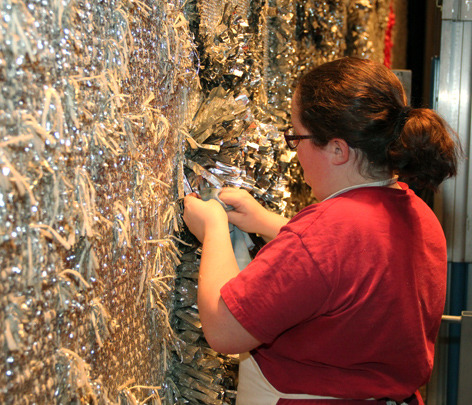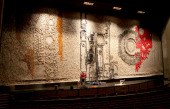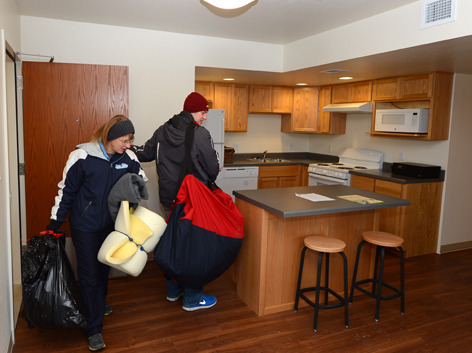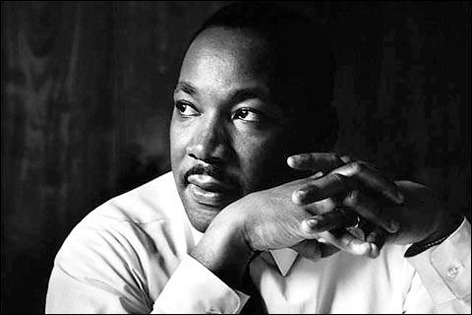Amid restoration, University Museums acquires Stephens curtain

Undergraduate Amy Lowery hand-cleans Mylar strips in the Stephens curtain. Photo by Alex Murphy.
With a target completion date of April 9, a small team is tackling a large job: restoring and cleaning the 2,800-square-foot curtain that has guarded the stage at Stephens Auditorium since the facility opened in 1969.
In mid-December, University Museums officially acquired the curtain for its Art on Campus collection. Museums textile conservation fellow Kate Greder has led the restoration work, assisted by anthropology undergraduate Amy Lowery. Additionally, Claire Kruesel, a master's student in creative writing and the environment, is assisting with research and publicity.
The facts
Title: Giniro-no-kigou ("Silver Code"), 1969
Designer: Mukai Ryokichi (1918-2010)
Produced at: Kawashima Textile Mills, Kyoto, Japan
Dimensions: 80 feet by 35 feet
Weight: 2,800 lbs.
Materials: Polyester, rayon, nylon, Mylar and polyvinyl chloride film
Cost: $20,500, commissioned by Bill and Dorothy Fisher
Kyoto-Ames transport: $50,000
Acquired for the Art on Campus collection: December 2013
Work began Aug. 26 on the stage side of the curtain, replacing rod pockets near its lower edge, stabilizing the backing and cleaning the back lining. The remaining seven months of the project – working around the building's performance schedule -- are devoted to the front of the tapestry.
Armed with a special conservation vacuum, small brushes, microfiber cloths and water, Greder and Lowery are hand-cleaning the curtain, inch by inch. Some days they'll clean as much as 20 square feet, some days as little as three.
"We haven't found any major staining, and it's in really sturdy condition," Greder said. "But there's a thick layer of dust covering everything. And we're lifting out things like dead bugs and pieces of confetti."
The university community is welcome to observe the cleaning process during two public sessions: Thursday, Feb. 6 (4-6 p.m.), and Sunday, March 2 (noon-2 p.m.).
Art on campus
Adding the curtain to the Art on Campus collection adds maintenance requirements, as well as an obligation for education/scholarship about it, said University Museums director Lynette Pohlman.

Hand-cleaning continues through early April on the Stephens curtain. Photo by Alex Murphy.
"We have wanted [the curtain] for many years. It's part of the cultural history of this university and many people have a story about it," she said. "If you don't maintain your cultural heritage, it will fade away."
Pohlman is investigating a potential second phase of restoration, for which University Museums will need to seek private gifts. Phase 2 work could replace the grommets at the top of the curtain and, depending on a consultant's recommendation, add a mechanized rigging system to raise and lower the 2,800-pound tapestry. During the curtain's first 44 years and 3,000-plus performances, that task has been accomplished with ropes, pulleys and determination.
Funds from the office of the vice president for business and finance and University Museums will cover the first phase of the restoration. The restoration project also is accruing funds in account 2311822, University Museums special programs and projects, at the ISU Foundation.
First group of Ph.D. programs selected for scholar funding
The provost's office has selected the first 22 graduate programs to receive central funding for an additional – and exceptional -- doctoral student under President Steven Leath's Presidential Scholars program announced in November. Seven of the programs selected are interdepartmental and two were submitted by two colleges.
With funding available for up to a combined 32 scholars over two years (FY14, FY15), up to 10 more programs could be selected for funding by August.
The goal of the initiative is to recruit top doctoral students in strategic program areas. It's one piece of Leath's broader plans to strengthen Iowa State's research and graduate programs. The initiative provides $25,000 to each program selected for a graduate assistant stipend and benefits for the first year. The student's home college provides a full tuition scholarship. A combination of the college/program/principal investigator provides a comparable or greater stipend for at least the second year of study.
All of the programs selected were top priorities identified by the colleges that proposed them; 13 of them also made a list of 16 programs identified by Graduate College leaders based on five years of growth in applicants and degrees awarded, and a National Research Council ranking.
Newly recruited Ph.D. students are expected to arrive on campus sometime between this month and August.
"The selection of student recipients will be by the faculty of the program using their normal process, with the expectation that the funding will be used for an additional Ph.D. student (beyond the number that normally would have been appointed) and that the students will be of high quality," wrote Graduate College dean Dave Holger in a memo to the college deans last month.
Ph.D. Presidential Scholars: FY14 program selections (22)
|
Program |
College |
|
Aerospace engineering |
CoE |
|
Bioinformatics/computational biology |
CALS |
|
Biomedical sciences |
CVM |
|
Business; unspecified (2) |
CoB |
|
Chemical and biological engineering |
CoE |
|
Civil, construction and environmental engineering |
CoE |
|
Computer engineering |
CoE |
|
Computer science |
LAS |
|
Ecology and evolutionary biology |
LAS |
|
Education, School of |
CHS |
|
Electrical engineering |
CoE |
|
English |
LAS |
|
Food technology |
CALS, CHS |
|
Genetics |
CALS, LAS |
|
Human development and family studies |
CHS |
|
Materials science and engineering |
CoE |
|
Molecular, cellular and developmental biology |
CALS |
|
Physics |
LAS |
|
Plant pathology/plant biology |
CALS |
|
Psychology |
LAS |
|
Statistics |
LAS |
Black: Designated as strategically important by the Graduate College (three others on that list of 16 are chemistry, economics and environmental science)
Blue: Designated as strategically important by the college
Freddy adds new neighbors

Keaton Carter, a sophomore from Altoona, moved into a new Fredericksen Court apartment Jan. 8 -- with some help from his mom, Sandy. Photo by Bob Elbert.
Two more buildings in the Fredericksen Court apartment complex are open, adding living space for 240 additional residents. Students began moving in Wednesday, Jan. 8.
Three apartment buildings opened in August and November, and another will be completed this month for use next fall. The six new buildings add 720 beds to the inventory of the Department of Residence complex, affectionately known as Freddy Court.
Students are coming to the new buildings from across the residence system, including other apartments and residence halls. By the start of the spring semester, hall dens that were converted to living quarters will return to use as community spaces.
With its six additions, the complex boasts 29 total apartment buildings. That translates into 688 units and 2,712 beds. Students must be at least 19 years old or in their second year at Iowa State to live in campus apartments.
A new parking area was built on the east side of Haber Road for residents, adding 540 spaces (Lot 112). The parking project included storm water management features and outdoor classroom opportunities in the former pasture area. In all, there are 2,034 parking spots for Fredericksen Court -- enough to accommodate 75 percent of residents. Photo by Bob Elbert.
The verdict on eText: Not yet
Reprinted from the Dec. 12, 2013, CIO News
In less than 20 years, personal computers and the Internet have changed the way we do nearly everything in our lives, reading included. But many technologies are still in development. One of those is eTexts. ISU was part of a recent study in which textbook content was provided online rather than in a traditional published and bound book.
The eText pilot took place fall semester 2012 in a program sponsored by Internet2 and EDUCAUSE. Each student who took a course in the pilot received an eText at no cost. An e-reader platform, called Courseload, was integrated with Iowa State's Blackboard learning management system.
Was it a success? Depends on who you ask. Going forward, the success of electronic textbooks will most likely be based on the type of content provided.
For kinesiology professor Greg Welk, the experiment was a success. Welk developed the text that was converted to eText by educational publisher McGraw Hill for the pilot.
Students in charge of their own learning
"With the explosion of the Internet and the Google mindset, students today are very savvy," Welk said. "This stuff comes naturally to them." Material in an eText flows more like a magazine, he said, and students can jump around between digestible chunks of information. "It allows students to be in charge of their own learning."
For example, one hyperlink within Welk's text takes the reader directly to the website of the American Heart Association, where the student can observe a demonstration of the latest CPR technique.
Another feature Welk likes about the eText is that he can annotate the text and share his annotation with his students. "That way I can show them, 'this is what's important here.'"
English lecturer Carla Weiner, however, isn't a fan of that particular feature. "I think some students over generalized the highlights, believing they only had to read highlights and not the rest of the text. So it became a shortcut rather than a true impact on learning," she said.
One eText book little more than converted PDF
Weiner teaches English 302, business communications, and for her class, the eText book was little more than a converted PDF. There were no hyperlinks or interactive features.
Some of the content for her class would be appropriate for more interactive text, she believes; however, not just prescriptive activities like true/false or multiple-choice quizzes.
"It would be great if the textbook had links to videos that inspired students to think about a scenario where they draw conclusions and record observations as short answers, followed by the opportunity to listen to an expert's view on the topic," she said.
Weiner said it was her observation that students read less of the text when it was online than when they have an actual book for her class.
"Students told me that when the book wasn't right in front of them, it was out of sight, out of mind."
Despite all the advances the Internet has brought, Weiner said "authors and publishers need to create content specifically designed for an online reading experience on devices that students will use. That takes time and a new way of thinking. Until they do, the online reading experience of textbooks falls short."
The report for the pilot project (PDF) is available on the eText project page of the CIO website.
What will eTexts cost?
As indicated in the report, students liked the free textbook in the pilot, and assume that electronic text will be cheaper than printed books. In fact, eText content eventually may be more expensive because of all the additional content that can be leveraged from other sources.
Students think it should be cheaper because of the savings in printing costs, but that ignores the potential of hyperlinks to new resources, and other things that print can't do.
There are market pressures that push publishers toward creating eTexts that are little more than simple PDFs, such as the eText Weiner used. It takes almost no time or money for a publisher to create an electronic version that mirrors the print text. However, it takes a lot of resources for a publisher to create a content-rich experience. Students' demand for lower cost may well impede the publisher's ability to create a richer online experience.
One of the challenges to this technology is in the term itself. As long as you're calling it an eText, you are going to have the inevitable comparison to a print textbook. But electronic content can be so much more than that.
ISU plans events to honor Martin Luther King Jr.

Martin Luther King Jr.
The university community has planned several activities to commemorate Martin Luther King Jr. Day, Jan. 20. All events are free and open to the public.
- "Let Freedom Ring" carillon concert, Jan. 15 (11:50 a.m., central campus). ISU carilloneur Tin-Shi Tam will play musical selections dedicated to the memory of King (live webcast).
- Documentary and discussion, Slavery by Another Name, Jan. 15 (7 p.m., Memorial Union, South Ballroom). Following the Civil War, new forms of forced labor emerged in the American South, keeping many African-Americans in bondage until World War II. Brian Behnken, associate professor of history, will lead a discussion following the 90-minute film.
- Community birthday celebration, Jan. 20 (6 p.m., Ames Middle School, 3915 Mortensen Rd). Celebrate King's birthday with cake, music and stories. A program begins at 6:30 p.m.
- Legacy convocation, Jan. 23 (3:30 p.m., MU Sun Room). Celebrate King's legacy and learn how his global vision for equality still is relevant today. The program features The Loving Story, a documentary about interracial marriage in the United States. A panel discussion will follow the film. The Advancing One Community Awards also will be presented.
- Lecture, "The History of White People," Nell Irvin Painter, Jan. 29 (8 p.m., MU Great Room). Painter is the Edwards Professor of American History, Emerita, at Princeton University, and the author of The History of White People and other books.
- Documentary and discussion, Freedom Riders, Feb. 3 (7 p.m., MU South Ballroom). From May through November 1961, more than 400 black and white Americans traveled together on trains and buses throughout the South. The group was called the Freedom Riders, and its actions were met with racism and mob violence. Freedom Riders chronicles their journey. Brian Behnken, associate professor of history, will lead a discussion following the film.
